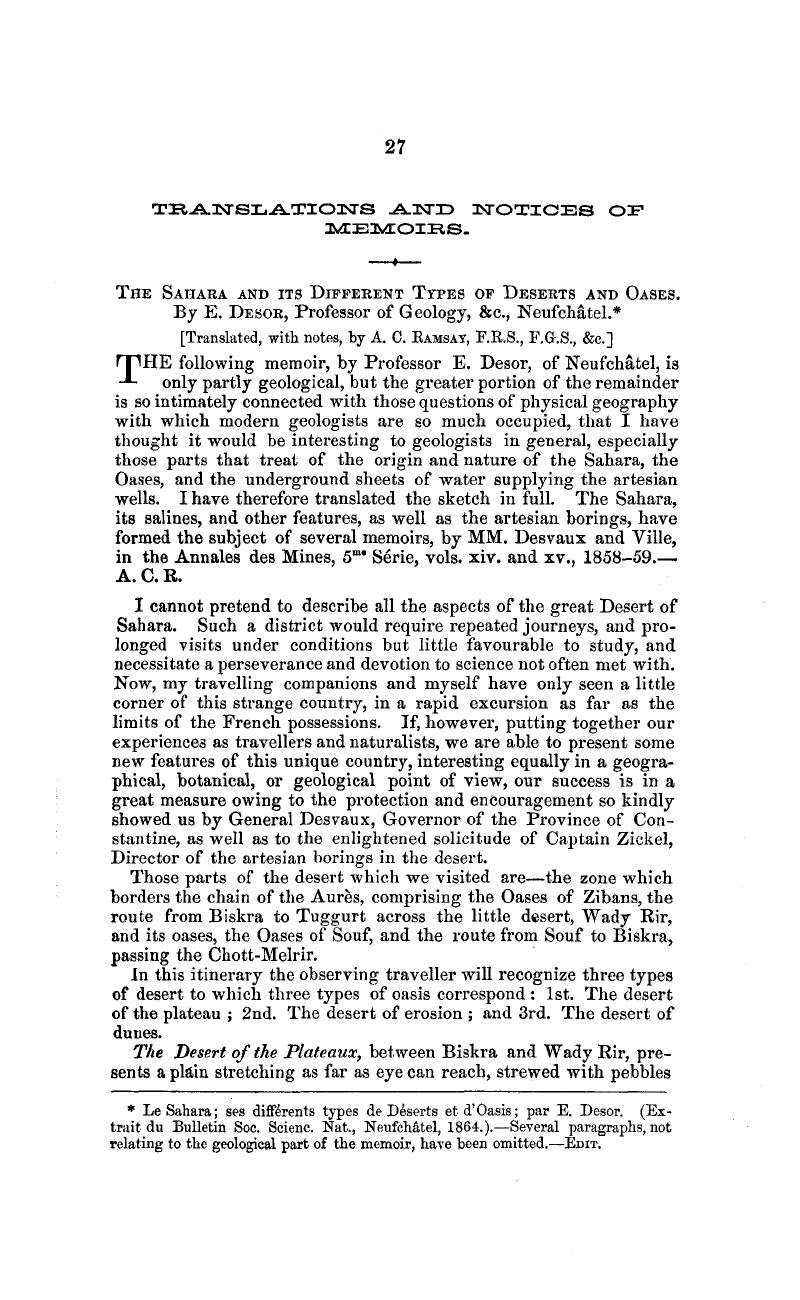No CrossRef data available.
Article contents
Translations and Notices of Memoirs
Published online by Cambridge University Press: 01 May 2009
Abstract

- Type
- Translations and Notices of Memoirs
- Information
- Copyright
- Copyright © Cambridge University Press 1864
References
* Le Sahara; ses différents types de Déserts et d'Oasis; par E. Desor. (Extrait du Bulletin Soc. Scienc. Nat., Neufchâtel, 1864.).—Several paragraphs, not relating to the geological part of the memoir, have been omitted.—Edit.
page 30 note * See Memoir by M. Ch. Laurent, Bullet. Soc. Géol. France, vol. xiv. p. 615, 1856–7.—A. C. R.
page 30 note † See observations made by Rev. Tristram, H. B., M.A., F.L.S., &c, in his work on ‘The Great Sahara’ (1860, Murray)Google Scholar; also Appendix to 3rd edition of Lyell's, ‘Antiquity of Man’ (12 1863), p. 28Google Scholar.—A. C. R.
page 31 note * See Prof. E. Suess on the evidences of a post-pliocene sea on the site of the Sahara; Trans. Roy. Imp. Geol. Institute of Vienna, Jan. 1863.—A. C. R.
page 31 note † In 1851 I published a paper in the Journal of the Geological Society on glacial phenomena, only part of which was printed, the remainder having been considered by the Council as too wild for publication in the Journal; and I therein stated, on the authority of the late Professor E. Forbes, that the Sahara ‘formed an extension of the sea in which the Sicilian Pleistocene beds were formed;’ but I am at this distance of time unable to recollect on what data he grounded this opinion. The diminution of the Alpine glaciers, both on the south and north sides of the chain, is however connected with phenomena of a much more general kind, which accompanied or caused the close of the ‘Glacial Period’ in both hemispheres, and we suspect of a kind not necessarily connected with any local phenomenon like the formation of the Sahara, however important that might have been in modifying part of the general result.— A. C. R.
page 33 note * A little fish strongly resembling the above, if not identical with it, has been described by Gervais, M. under the name of Tellia apoda (Annales des Sc. Nat. 1853, vol. xix. p. 14)Google Scholar. It unites all the characteristics of our fish, with the exception of the ventral fins. It is said to be a native of Tell, south of Constantine.
page 33 note † Revue et Magasin de Zoologie, 1859, tom. xi. p. 377.—E. D. See also Mr. Tristram's work on ‘The Great Sahara’ (already referred to). Mr. Tristram obtained specimens of Cyprinodon dispar, Lin., from the hot springs near Biskra; and Dr. Günther described them in a paper in the Zool. Proceed., 1859, p. 469.—A. C. R.
page 33 note ‡ But is it not possible that the fish, before rising in the waters of the wells, have been first carried down from the outer surface at a distance to the underground reservoirs that contain the waters underneath the surface of the Sahara?—A. C. R.




